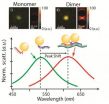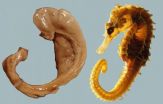Gold nanoparticles help target, quantify breast cancer segments in a living cell
2014-04-23
(Press-News.org) WEST LAFAYETTE, Ind. - Purdue University researchers have developed a way to detect and measure cancer levels in a living cell by using tiny gold particles with tails of synthetic DNA.
A team led by Joseph Irudayaraj, professor of agricultural and biological engineering, used gold nanoparticles to target and bind to fragments of genetic material known as BRCA1 messenger RNA splice variants, which can indicate the presence and stage of breast cancer. The number of these mRNA splice variants in a cell can be determined by examining the specific signal that light produces when it interacts with the gold nanoparticles.
"This is a simple yet sophisticated technique that can be used to detect cancer in a single cell and determine how aggressive it is," said Irudayaraj, who is also the deputy director of the Bindley Bioscience Center. "Being able to quantify these genetic molecules could ultimately help clinicians provide better and more individualized treatment to cancer patients."
The technique also could increase our understanding of cell biology and paves the way for genetic profiling and diagnosis based on a single cell, Irudayaraj said.
BRCA1 is a tumor suppressor gene that can transform a cell into a cancerous type under certain circumstances. Measuring the number of BRCA1 mRNA splice variants in a cell can indicate if the gene is being under-expressed, a possible sign of breast cancer.
But current methods of detecting cancer rely on samples made up of hundreds or thousands of cells and cannot provide detailed information about how genes tied to cancer are being expressed in individual cells.
Irudayaraj and his team are the first to detect and quantify BRCA1 mRNA splice variants - fragments of genetic material that are removed when mRNA is formed - in a single cell. Splice variants can determine the fate of a cell and how specific proteins are expressed. Errors in the splicing process have been linked to a variety of diseases.
"With this method, we are basically able to spot a needle in a haystack - and we can determine if there are five needles in that haystack or if there are 50," he said.
Irudayaraj and his then-graduate research assistant, Kyuwan Lee, who is the first author of the study, adapted common nanotechnology methods to tackle the challenge of pinpointing mRNA splice variants in a living cell. They fabricated gold nanoparticles - more than 1,000 times smaller than the diameter of a human hair - and tagged them with strands of DNA complementary to BRCA1 mRNA splice variants.
When injected into a cell, the nanoparticles attached to either end of mRNA splice variants, forming structures known as dimers - each "like a couple holding hands," Irudayaraj said.
Because dimers give off a unique signal in the presence of light, the researchers could measure the number of dimers by illuminating the cell with a simple light source. The number of dimers corresponded to the number of BRCA1 mRNA splice variants in a cell.
Light behaves differently when it shines on a single gold particle, allowing the researchers to differentiate between dimers and free-floating gold particles.
The researchers used two methods to quantify the dimers: spectroscopy, which measures the way light scatters when it encounters an object, and a colorimetric image on which dimers show as reddish dots while single gold particles appear green.
The technique can quantify mRNA splice variants in a single cell in about 30 minutes.
Irudayaraj is modifying the system to speed up the process so that it can be used in tissue biopsies.
"If we can quantify key mRNA at single cell resolution in a tissue biopsy, that will be very powerful in terms of refining treatment protocols for key diseases," he said.
INFORMATION:
The paper was published in Nature Nanotechnology on April 20 and is available at http://www.nature.com/nnano/journal/vaop/ncurrent/full/nnano.2014.73.html.
The National Science Foundation, the Indiana Clinical Transitional Sciences Institute, the Purdue Center for Cancer Research, Samsung and Stanford National Institute of Health funded the research.
ELSE PRESS RELEASES FROM THIS DATE:
Study identifies enzymes that help fix cancer-causing DNA defects
2014-04-23
Purdue University researchers have identified an important enzyme pathway that helps prevent new cells from receiving too many or too few chromosomes, a condition that has been directly linked to cancer and other diseases.
Mark Hall, associate professor of biochemistry, found that near the end of cell division, the enzyme Cdc14 activates Yen1, an enzyme that ensures any breaks in DNA are fully repaired before the parent cell distributes copies of the genome to daughter cells. This process helps safeguard against some of the most devastating genome errors, including the ...
A key to enjoying massive online photo files may be giving up some control
2014-04-23
PITTSBURGH—The ability of individuals to store and instantly access thousands of their photos online has become a commonplace luxury, but the sheer size of these archives can be intimidating. Researchers at Carnegie Mellon University and Microsoft Research Cambridge, UK, have found people might actually enjoy their collections more by giving up a bit of control and learning to wait.
Their 14-month study showed that people reflected more on past events and developed a renewed interest in their online photos when a device called Photobox would randomly print four or five ...
AGU: Odds of storm waters overflowing Manhattan seawall up 20-fold, new study shows
2014-04-23
WASHINGTON, D.C. -- Maximum water levels in New York harbor during major storms have risen by nearly two and a half feet since the mid-1800s, making the chances of water overtopping the Manhattan seawall now at least 20 times greater than they were 170 years ago, according to a new study. Whereas sea-level rise, which is occurring globally, has raised water levels along New York harbor by nearly a foot and a half since the mid-19th century, the research shows that the maximum height of the city's "once-in-10-years" storm tide has grown additionally by almost a foot in that ...
Study finds long-term survival of human neural stem cells transplanted into primate brain
2014-04-23
Putnam Valley, NY. (Apr. 23 2014) – A team of researchers in Korea who transplanted human neural stem cells (hNSCs) into the brains of nonhuman primates and assessed cell survival and differentiation after 22 and 24 months found that the hNSCs had differentiated into neurons at 24 months and did not cause tumors.
The study will be published in a future issue of Cell Transplantation but is currently freely available on-line as an unedited early e-pub at: http://www.ingentaconnect.com/content/cog/ct/pre-prints/content-ct1117Antonucci2.
The hNSCs were labeled with magnetic ...
Scientists identify source of mysterious sound in the Southern Ocean
2014-04-23
Scientists have conclusive evidence that the source of a unique rhythmic sound, recorded for decades in the Southern Ocean and called the "bio-duck," is the Antarctic minke whale (Balaenoptera bonaerensis). First described and named by submarine personnel in the 1960s who thought it sounded like a duck, the bio-duck sound has been recorded at various locations in the Southern Ocean, but its source has remained a mystery, until now.
In February 2013, an international team of researchers deployed acoustic tags on two Antarctic minke whales in Wilhelmina Bay off the western ...
Autologous stem cell therapy improves motor function in chronic stroke victims
2014-04-23
Putnam Valley, NY. (Apr. 23, 2014) – People who have had a stroke, often suffer motor deficits with little potential to restore neurological function. However, a study conducted in Taiwan, that will be published in a future issue of Cell Transplantation, but is currently freely available on-line as an unedited early e-pub at: http://www.ingentaconnect.com/content/cog/ct/pre-prints/content-ct1168Chen, has found that when one group of stroke victims had their own peripheral blood stem cells (PBSCs) injected directly into the brain and a similar group did not, those who received ...
Too many chefs: Smaller groups exhibit more accurate decision-making
2014-04-23
The trope that the likelihood of an accurate group decision increases with the abundance of brains involved might not hold up when a collective faces a variety of factors — as often happens in life and nature. Instead, Princeton University researchers report that smaller groups actually tend to make more accurate decisions while larger assemblies may become excessively focused on only certain pieces of information.
The findings present a significant caveat to what is known about collective intelligence, or the "wisdom of crowds," wherein individual observations — even ...
Community-based weight loss program aids diabetes management
2014-04-23
Weight loss and control of blood sugar can reduce the risk of complications in patients with diabetes but this is difficult for many to achieve. A University of California, San Diego School of Medicine randomized controlled trial of obese adults with type 2 diabetes suggests that participants enrolled in a community-based structured weight loss program are able to shed more pounds, improve blood sugar control and reduce or eliminate insulin use and other medications compared to a control group.
"Support and a tailored lifestyle intervention have been shown to reduce cardiovascular ...
Physical activity keeps hippocampus healthy in people at risk for Alzheimer's disease
2014-04-23
COLLEGE PARK, Md. – A study of older adults at increased risk for Alzheimer's disease shows that moderate physical activity may protect brain health and stave off shrinkage of the hippocampus– the brain region responsible for memory and spatial orientation that is attacked first in Alzheimer's disease. Dr. J. Carson Smith, a kinesiology researcher in the University of Maryland School of Public Health who conducted the study, says that while all of us will lose some brain volume as we age, those with an increased genetic risk for Alzheimer's disease typically show greater ...
Chemical companies shore up supplement science
2014-04-23
As evidence mounts showing the potential health benefits of probiotics, antioxidants and other nutritional compounds, more and more people are taking supplements. And the chemical industry is getting in on the action. But legitimate skepticism about supplements' health effects could deter growth, so the industry is responding with clinical research to shore up health claims, according to the cover story in Chemical & Engineering News (C&EN), the weekly news magazine of the American Chemical Society.
Melody M. Bomgardner, a senior editor at C&EN, writes that about half ...




